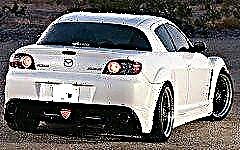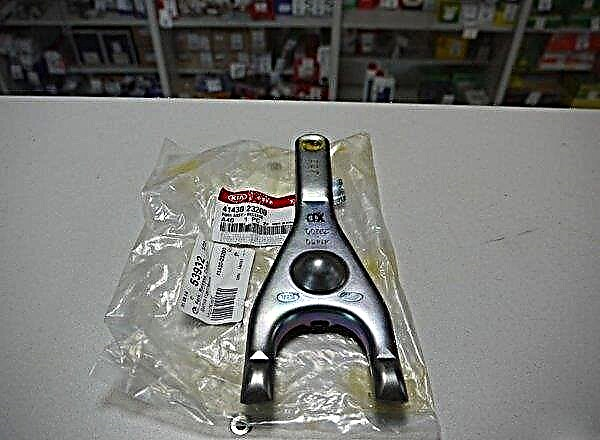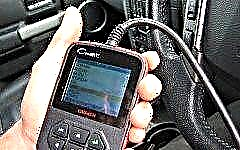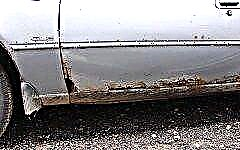

The content of the article:
- How the body wears out
- Detection of rotten body areas
- Repair of rotten door sections
- Repair of rotten thresholds
We all know that cars are made of metal. We also know that even the metal parts of a car are subject to wear and tear. Some parts or even entire mechanisms can be sorted out and replaced if necessary. But when the body and its elements wear out, much more work will be required, especially in the presence of rotten parts.
How the body wears out

The costs of body repair will be significant if you entrust the work to specialists at the station who have the necessary equipment and tools. Can you try to repair some parts of the body yourself? It is possible, but this will take more time and effort, since in garage conditions it is more difficult to gain access to difficult sections of the skeleton.
First of all, when buying a used car, pay special attention to damage to the body:
- body wear due to age;
- body wear due to corrosion formation;
- damage to the skeleton due to the participation of the machine in accidents.
Metal wear due to age cannot be stopped. Even if the owner of the car carefully monitored that it constantly shone, he cannot stop the aging of metal parts. Cracks caused by metal fatigue lead to sagging doors, difficulties in opening and closing locks, etc.
If the car has been in an accident and its marks remain on the body, it may be necessary to replace the damaged parts of the frame. There is such a service - "non-contact removal of dents", which, according to the plunger principle, allows you to get rid of some post-accident damage. But if rust got down to business, a more serious approach to repairs would be required to prevent further "eating up" of the car skeleton.
Detection of rotten body areas

It is not difficult to find some rotten elements of the frame - you open the car door and see that it rotted in the lower part along with the threshold. However, rust has a bad hiding property, and sometimes it can be difficult to find it.
A potentially rotten door will need to be fully opened and attempted to lift slightly. When a backlash appears, which is accompanied by not the most pleasant rubbing sounds, one can safely judge the wear of the door hinges and the need to disassemble it. And, most likely, when you disassemble the door, you will see that some of its parts are finally destroyed by corrosion.
It will also not be difficult to detect rusted parts of the threshold - a visual inspection is carried out in order to find rust spots. And if even the smallest areas of corrosion are found, it is recommended to restore the worn-out area, otherwise, otherwise, the rust will continue to eat everything up.
Sometimes access to the insides of the threshold is hidden by molding - in this case, it must be removed, and in some cases you will see that a significant metal part has been destroyed.
Repair of rotten door sections

As we have already found out, when a backlash appears in a certain place of the door, most likely corrosion occurs. There is practically no air flowing there, so the door starts to rot from this part. Corrosion destroys metal from the inside, so it is difficult to notice at first.
The principle of repairing rotten door sections is as follows:
- First of all, you need to get rid of the area that has completely rotted. This will come in handy with scissors for metal, which gently remove the decayed part. Try to keep chips as little as possible.
- The cut out part is not immediately thrown away, since it is necessary to make a patch according to its size, preferably from the same metal. In this case, it is better to make the patch with a certain margin, so that then it can be welded overlapping to the whole part of the door.
- Next, you need to get rid of the rust on the part of the door to which you intend to weld. Small bursting chips are removed with a grinder or a file, and only areas touched by corrosion are smoothed with sandpaper.
- When the integral part is cleaned of corrosion, we start the patch and weld it overlapping to secure the door structure.
- We get rid of the seams and metal chips remaining after welding with a file, grinder or grinding wheel, trying to give a more or less smooth surface.
- Next, a coarse putty is applied, which can be purchased at automotive stores.
- When the putty layer dries up, it must be treated with 80 grit sandpaper. After that the layer is additionally smoothed with 120 grit sandpaper. For cleaning, you can also use a grinding wheel, which significantly speeds up the processing process. But manual stripping gives a better and more uniform finish.
- Next, we apply the finishing putty, after which the surface is also processed with sandpaper, this time with a grain of 220 and 320.
- The brushed surface is primed, and when the primed layer is completely dry, paint is applied.
If the door is very rotten, you can also try to repair the rotted parts. However, this will require much greater financial and time costs, so in some cases it will be more expedient to replace completely rotted doors - especially if you operate a car of a domestic manufacturer, because the price tags for body parts are not very high for them.
Repair of rotten thresholds

The threshold is a three-component structure:
- outer part of the threshold;
- threshold amplifier;
- threshold connector.
These elements are connected to each other using spot welding. And all components can be subject to corrosion at once. For this reason, at the beginning of the repair of the thresholds, it will be necessary to remove the doors of the "iron horse" and only then start work:
- The outer part of the rotten threshold will also need to be removed. First, we get rid of the rusty front sills, and only then we take up the rear ones. Last but not least, remove the decayed areas between the front and rear sills.
- The rusty amplifier is removed, but not completely - we leave a small part on which a new one will be welded. It is recommended to leave a small part of the connector as well.
- The remaining integral parts of the threshold, as well as potential weld areas, are cleaned from corrosion.
- First, a new connector is welded, to which a fresh sill connector is subsequently welded.
- After that, the remaining welded seams must be removed so that the threshold is evenly attached to the body.
- The outer part of the sill is neatly butt welded to the rest to avoid unevenness or gaps.
- It remains only to weld the connector to the lower part of the body, treat the integral structure of the sill with one or two coats of primer, and then paint it.
It is not very difficult to repair rotten parts of the body if you have a welding machine, abrasive tools, and most importantly, desire and time. If you do not have free time, it will be more expedient to contact the station for help so that qualified specialists can quickly and efficiently repair the rotted body.











